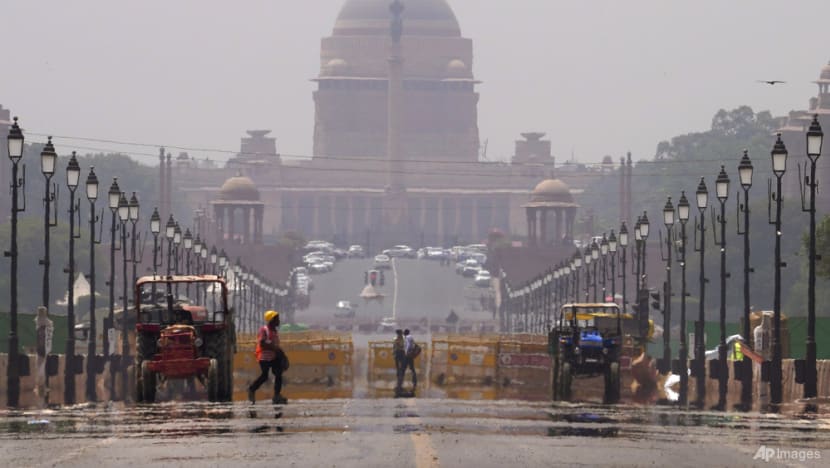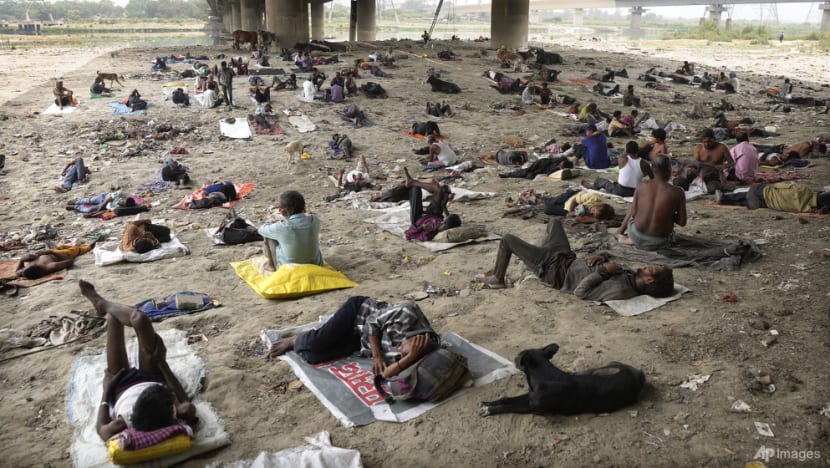Commentary: New Delhi’s heatwaves carry a warning for the rest of the world
Nowhere else are so many people exposed to such extreme heat that they do not have the means to withstand – an alarming precursor of the conditions that millions around the world can expect to face when climate change worsens, says the Financial Times' Benjamin Parkin.

A construction worker walks across a mirage created on a road following a heat wave, in New Delhi, May 2, 2022. (AP Photo/Manish Swarup)
NEW DELHI: One of the highlights of life in New Delhi is the spring. For a few glorious weeks in February and March, rays of golden sun break through the dissipating winter smog and jamun trees, warming the residents of India’s capital after months of biting cold. An uptick in temperatures ahead of the summer is balanced by small pleasures, such as the street carts that arrive resplendent with mangoes and other summer fruit.
That gentle cycle was abruptly cut short this year. No sooner had the winter chill lifted than the relentless heatwaves began. Last March was the hottest on record, with temperatures in Delhi crossing 40 degrees Celsius in April and touching 49 degrees Celsius in May.
It was a pattern repeated across much of the Indian subcontinent. In the Pakistani city of Jacobabad, temperatures often pass 50 degrees Celsius, sometimes reaching levels at which humans can no longer survive.
HEATWAVES ARE THE NEW NORMAL
Heatwaves are becoming the new normal across the region. A study by the UK Met Office found that chances of a record-breaking heatwave in India and Pakistan are 100 times more likely due to climate change.
Nowhere else on earth are so many people exposed to such extreme heat. This is also, researchers say, an alarming precursor of the sorts of conditions that millions around the world can expect to face.
“This South Asian region is a poster child for climate change,” says Roxy Mathew Koll, a climate scientist at the Indian Institute of Tropical Meteorology. He points to recent heatwaves all over the world, in the UK and elsewhere. “It’s not just India, though India is facing the worst scenario.”
Those who can retreat to air-conditioned bubbles: Many middle-class and wealthy Indians opt to spend their weekends at the mall instead of, say, the park. In an absurd twist, I often catch wintry sniffles from visits to freezing offices, shops or restaurants.
But escaping the heat is a luxury. Only 5 per cent of Indian households had air conditioning in 2018, according to the International Energy Agency, compared to 90 per cent in the US.
MARGINALISED POOR ARE THE HARDEST HIT
Economists estimate that as many as 80 per cent of jobs in India are informal, often outdoors in farming or construction, leaving workers exposed to relentless, extreme heat. This is compounded in cities, where the concrete traps the warmth.
Consider Mahesh Yadav and Srimati Devi, a couple in their 50s who migrated from the eastern state of Bihar to Delhi 20 years ago. They are among the capital’s most marginalised residents, living in a slum of plywood and tarpaulin shacks alongside a railway track without electricity or running water.
With no fan to cool them, they sleep on the concrete steps of a nearby overpass for some breeze at night. Yadav, a cycle rickshaw puller, has developed a rash along his back from incessantly sweating. “The doctor said I have to rest,” he says. “But I can’t afford to sit at home.”
Extreme weather has severe economic and health-related consequences. A 2021 study in the Lancet found that India and other South Asian countries were among the worst-hit globally by productivity losses and heat-related mortality.

Amir Bazaz, a researcher at the Indian Institute for Human Settlements, argues that heat stress can, like COVID-19, tip vulnerable families into poverty as breadwinners find themselves struggling to work.
“The heart of the problem is the nature of the economy in Indian cities, which is hugely informal,” he says. “A minor shock can pull you down deep into the poverty trap.”
As Indian authorities invest in renewable energies and other resources to help limit rising temperatures, they are also focused on adapting. Local “heat action plans” aim to help cities with everything from early warning systems to investment in “cool roofs” that deflect sunlight away from buildings. But researchers like Koll say more is needed.
India’s heatwaves have knock-on effects for the rest of the world. After this year’s early heat damaged crops including wheat, Indian authorities banned exports in a move that helped pushed up food prices globally.
A bout of recent rain has helped bring down Delhi’s temperatures a few merciful degrees. Parks are once again filling up in the evenings with joggers and children enjoying their summer holidays.
Some children, however, can’t wait to get back to class. Vineeta, a 17-year-old neighbour in Yadav and Devi’s slum, says school is the only time she gets some respite from the heat. “At least there’s a fan,” she says.













